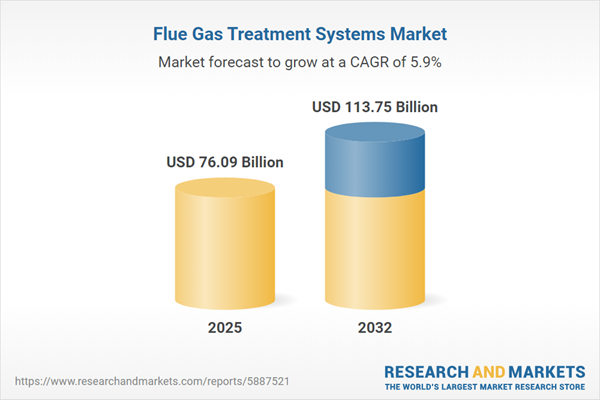Speak directly to the analyst to clarify any post sales queries you may have.
The flue gas treatment systems market is undergoing rapid change as organizations prioritize regulatory compliance, operational reliability, and investment in digital emissions infrastructure to drive business growth. Senior leaders are seeking actionable intelligence to inform investment decisions and ensure alignment with evolving regulatory and operational requirements.
Market Snapshot: Flue Gas Treatment Systems Market Overview
The global flue gas treatment systems market demonstrates steady growth, supported by the increasing pace of industrialization in regions with expanding energy, manufacturing, and processing sectors. Stringent environmental regulations are driving enterprises, particularly in power generation, cement, steel, and petrochemicals, to upgrade emissions controls and pursue digital modernization. Industry players are accelerating the adoption of integrated, flexible solutions to maximize system efficiency and enhance operational responsiveness amid diverse and changing compliance landscapes. Investments in rapid deployment technology and tailored approaches are crucial to gaining a competitive edge as market conditions and regulatory expectations shift.
Scope & Segmentation: Flue Gas Treatment Systems Market Insights
This report offers an in-depth breakdown of the flue gas treatment systems market, empowering senior executives to make well-informed decisions regarding capital allocation, operational optimization, and adherence to compliance mandates.
- Technology: Includes Activated Carbon Injection for emissions removal; Electrostatic Precipitators and Fabric Filter systems to enhance particulate and dust management; Desulfurization options such as Circulating Dry Scrubber, Spray Dryer Absorber, Limestone Forced Oxidation, Limestone Gypsum, and Sea Water Scrubbing; as well as Selective Catalytic and Non-Catalytic Reduction for nitrogen oxide mitigation. Catalysts utilized in these processes may feature vanadium, titania, zeolite, ammonia, or urea.
- Application: Solutions are tailored for sectors such as cement manufacturing, petrochemical processing, steel production, and power generation, ensuring each meets distinct efficiency and compliance challenges dictated by regulatory authorities.
- End User: Principal users include cement plants, steelworks, utility power companies (public and private), and key industrial operators requiring high-performance emission controls, consistent uptime, and regulatory reliability.
- Sales Channel: Engagement channels comprise aftermarket service providers, specialist distributors, and original equipment manufacturers, each delivering technical system installation, continuous maintenance, and comprehensive lifecycle asset management.
- Regional Coverage: Market dynamics and operations are influenced by industrial activities and regulation across the Americas, Europe, Middle East, Africa, and Asia-Pacific. Countries such as the UK, Germany, France, Russia, UAE, Saudi Arabia, South Africa, Kenya, China, India, Japan, Australia, South Korea, Indonesia, Thailand, Malaysia, Singapore, and Taiwan represent pivotal national markets.
- Prominent Industry Players: Key contributors shaping technical innovation, partnerships, and competitive benchmarks include Babcock & Wilcox Enterprises, Mitsubishi Hitachi Power Systems, Johnson Matthey, Andritz AG, FLSmidth & Co. A/S, Hamon & Cie, Thermax Limited, Doosan Lentjes, Haldor Topsoe, and DuPont de Nemours.
Key Takeaways for Senior Decision-Makers
- Digital transformation plays an essential role in meeting regulatory requirements and enabling more agile, data-driven plant operations.
- Utilization of real-time data analytics provides greater oversight and faster system optimization, supporting rapid responses to compliance and operational changes.
- Collaborative engagement with technology and catalyst specialists helps senior teams develop emissions control strategies adapted to complex, multi-national operations.
- Embracing modular and scalable system architectures allows organizations to phase upgrades, aligning capital expenditure with evolving sustainability strategies and modernization initiatives.
- Proactive access to predictive and aftermarket maintenance services lowers unplanned downtime and helps organizations sustain operational continuity across compliance scenarios.
Tariff Impact on Strategic Sourcing and Cost Structures
Recent tariff shifts in the U.S. have prompted organizations within the flue gas treatment systems market to review their sourcing and procurement tactics. As a result, firms are strengthening supplier relationships, redesigning logistics frameworks, and enhancing asset management practices to navigate cost fluctuations and maintain market stability.
Methodology & Data Sources
This report’s findings are based on comprehensive analysis of regulatory trends, market movements, and economic drivers affecting the flue gas treatment systems market. Research includes interviews with plant managers, technology providers, and compliance officers, as well as workshops that capture senior leadership priorities.
Why This Report Matters
- Enables executive teams to optimize capital investments and reduce operational risks during system upgrades or new deployments.
- Equips leaders with intelligence for proactive adaptation to changes in procurement, particularly those resulting from new tariff conditions, enhancing supply chain flexibility.
- Guides top management in decision-making related to technology adoption to sustain compliance and operational efficiency as regulatory environments evolve.
Conclusion
This report translates current regulatory and market developments into actionable guidance, supporting senior decision-makers in maintaining operational excellence and ongoing compliance in the dynamic flue gas treatment systems market.
Additional Product Information:
- Purchase of this report includes 1 year online access with quarterly updates.
- This report can be updated on request. Please contact our Customer Experience team using the Ask a Question widget on our website.
Table of Contents
3. Executive Summary
4. Market Overview
7. Cumulative Impact of Artificial Intelligence 2025
Companies Mentioned
The companies profiled in this Flue Gas Treatment Systems market report include:- Babcock & Wilcox Enterprises, Inc.
- Mitsubishi Hitachi Power Systems, Ltd.
- Johnson Matthey PLC
- Andritz AG
- FLSmidth & Co. A/S
- Hamon & Cie, S.A.
- Thermax Limited
- Doosan Lentjes GmbH
- Haldor Topsoe A/S
- DuPont de Nemours, Inc.
Table Information
| Report Attribute | Details |
|---|---|
| No. of Pages | 195 |
| Published | November 2025 |
| Forecast Period | 2025 - 2032 |
| Estimated Market Value ( USD | $ 76.09 Billion |
| Forecasted Market Value ( USD | $ 113.75 Billion |
| Compound Annual Growth Rate | 5.9% |
| Regions Covered | Global |
| No. of Companies Mentioned | 11 |









